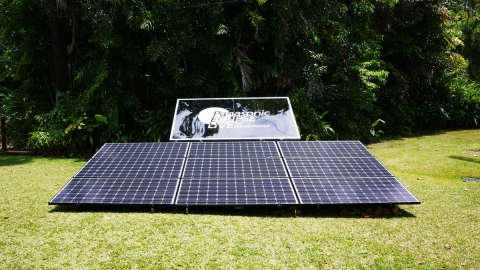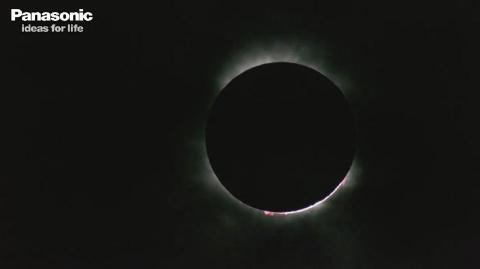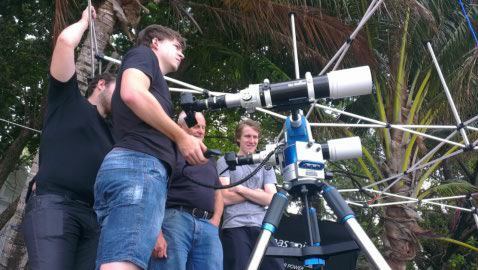OSAKA, Japan--(BUSINESS WIRE)--On the morning of November 14, 2012, the North of Australia witnessed a total solar eclipse. Panasonic, powered solely by its HIT(R) solar panels and lithium-ion batteries for storage, succeeded in a live broadcast of this spectacular astronomical phenomenon via USTREAM.
Here's a flash report by Correspondent reporter, Scott Mellish, product and technology trainer at Panasonic Australia!
http://youtu.be/_KUl0zkcYX8
The solar eclipse was broadcasted from two bases at seashore, Port Douglas and Fitzroy Island, 60km far northwest and 30km respectively from Cairns. A few days prior to the spectacular moment, the sun was often shyly hiding in the clouds but at the moment of the total eclipse, the sun stood out among the intervals of cloudy weather and Panasonic's LUMIX GH2 attached through a telescope captured the dramatic moment for about two minutes.
The challenging 'eco-friendly' live broadcasting to the world via Ustream achieved a total of over 800,000 viewers at the two bases as a result of mainly word-of-mouth, especially on social media like Twitter and Facebook. Thank you to all those who participated!
The epic challenge to "Filming the sun, using the sun" is a second for Panasonic after the annular eclipse live from Mount Fuji, Japan in May 2012. Panasonic, as one of leading energy solutions' brands will continue to use our technologies and ideas for life to share such emotional, moving events in the near future. Stay tuned!
[Recorded Live]
Dual Screen of the Main and the Sub *Available on PC only. / Facebook
https://www.facebook.com/PanasonicEclipseLiveBySolarPower/app_435671416492320
Main camera : Port Douglas / Ustream
http://www.ustream.tv/recorded/26970007
Sub camera : Fitzroy Island / Ustream
http://www.ustream.tv/recorded/26968399
[Photo Stream]
http://www.facebook.com/PanasonicEclipseLiveBySolarPower/photos_stream
[System Used]
Power Generation:HIT® Solar Panel VBHN235SE10×9
Power Storage: Portable Power Storage CB-LS01H×30
Video Capture: Full HD Camera LUMIX GH2×6
Other: Toughbook (Note PC), Equatorial Telescope, etc.
To view product photos: http://news.panasonic.net/archives/2012/1011_13735.html#system_used
About the Total Solar Eclipse
A total solar eclipse occurs when the moon crosses between the sun and Earth, therefore effectively concealing the whole body of the sun from view. Since the total eclipse is a phenomenon in which the sun itself can't be seen, it is actually the hot gases of the Corona, the so called "diamond ring" and the "prominence" that we can actually observe. The viewing path from which someone is able to observe a total solar eclipse in its totality is very narrow, and therefore you would be lucky to see this even once in a lifetime.
[Related Links]
About This Project
http://www.facebook.com/PanasonicEclipseLiveBySolarPower/app_495466917130140
Press Kit Page (Previous Releases, Materials for Media, Blogger, etc)
http://news.panasonic.net/presskits/eclipselive_by_solarpower2
The Previous Project Report Video
http://ch.panasonic.net/contents/10226/
Contacts
Panasonic Corporation
Hisao Tsugita
presscontact@ml.jp.panasonic.com
Advertising & Sponsorship Group,
Groupwide Brand Communications Division

Panasonic HIT(R) solar panels in the power generation for the live broadcasting (Photo: Business Wire)

Panasonic's LUMIX GH2 attached through a telescope captured the dramatic moment for about two minutes. (Photo: Business Wire)

Available to see the hot gases of the Corona (Photo: Business Wire)

Panasonic's LUMIX GH2 attached through a telescope (Photo: Business Wire)




